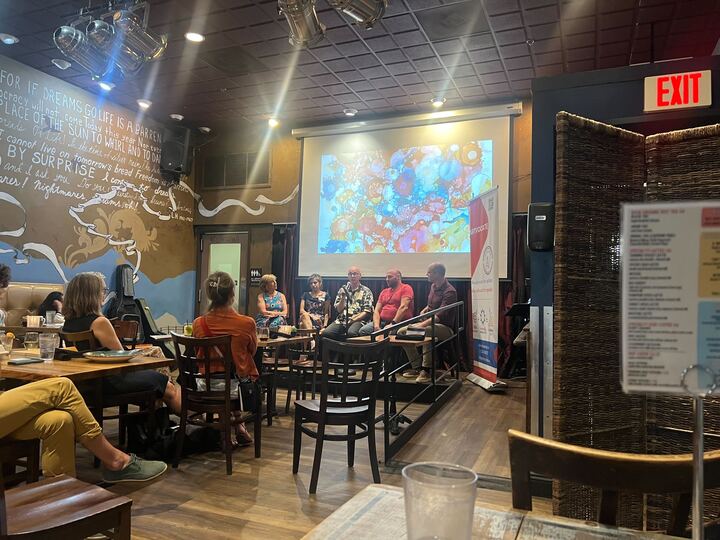
ALLIE STEVENS/THE HOYA | The restaurant Busboys and Poets hosted an event on September 5th about how science and art intersect in discussions about longevity.
Busboys and Poets, a local restaurant chain that prides itself on events to inspire social change, hosted a Science and Art Cafe event titled “Decoding Longevity: Who Controls Your Lifeline?” on Sept. 5.
The Science and Art Cafe — organized by Syahidah Osman, founder of Artvocate, and Ona Ambrozarite, co-director of the Johns Hopkins Science Diplomacy Hub — is a monthly event at Busboys and Poets locations with the goal of making important topics in science and art accessible to the general public.
Osman and Ambrozarite began working together on these events to bridge the gap between science and art.
“I’m very interested in providing intersectional dialogue amongst the community,” Osman told The Hoya. “The whole idea is to bring the science data to the community level and not just an academic space where it can be completely dry.”
This specific session aimed to explore the intersection of science, art and human longevity, inviting community members to engage in discussions on how long humans can live and the implications of life extension. It brought together a mix of scientists, artists and creatives, including Richard Todd Stafford, the evening’s host and a science communicator at George Mason University, who guided the audience through a panel of scientific insights and artistic interpretations of aging and longevity.
Shelley Lowenstein, an artist located in Washington, D.C., began the event by unveiling her beta cell-inspired artwork, which depicts the function of beta cells and their role in producing insulin, which offered perspective on how longevity relates to type 1 diabetes. Lengthening and improving the quality of life of people with type 1 diabetes was a major focus of the event.
Georgetown student Jillian Murphy (SON ’27) attended the event to explore how scientific advancements in longevity intersect with health care and patient care.
Murphy said she was particularly interested in Lowenstein’s artistic perspective of beta cells.
“I thought it was interesting to learn about beta cells in a scientific way, as well as an artistic way, because it was easier to comprehend and open the conversation of beta cells and the impact they have to a wider number of people, particularly those with type 1 diabetes,” Murphy told The Hoya.
Panelist Bella Patnaik, an ophthalmologist (a doctor who specializes in eye disorders), followed Lowenstein’s presentation, sharing her holistic view on eye health, longevity and the arts while also encouraging attendees to consider the broader connections between physical well-being and artistic expression. Next, Tomas Drgon, a musician and data scientist, discussed how his musical practice relates to longevity.
Meanwhile, Maksim Tsvetovat, an interdisciplinary scientist and jazz musician, provided an in-depth analysis of the science behind senescence, the process of biological aging. The night concluded with a musical performance by jazz vocalist Cybele Mayes-Osterman.
The panel also discussed ethical considerations related to increasing the human lifespan. Osman said she appreciated that the event provided a space to tackle these questions.
“We have to worry about population, right? With an increased population, is it the length of life we want, or is it the quality of life? And for me, this event is such a safe place to ask this kind of question,” Osman said.
During the panel, Lowenstein said she believed that with consistently improving technologies, including those developed to treat diabetes, the world will be able to better adapt to a larger population.
“There are a lot of people who can’t afford insulin right now,” Lowenstein said at the event. “That being said, there are technologies being developed where we may limit the need for insulin by using stem cell therapy.”
The event also aimed to approach longevity holistically by featuring interdisciplinary professionals and encouraging audience members to contribute opinions. Murphy said this approach made the conversation more accessible to people not involved in longevity research.
“I think that because it was a panel, you have so many different perspectives, so when they were discussing things and when people from the audience were asking questions, the conversation was easy to follow, even as someone who didn’t know much about longevity going into it,” Murphy said.
According to Stafford, the average lifespan has doubled since 1900, which Patnaik said could lie in small, everyday choices.
“Those little things that doctors tell you –– drink water, eat healthy, exercise –– there’s a reason they say those things,” Patnaik said at the event. “They actually make a difference.”